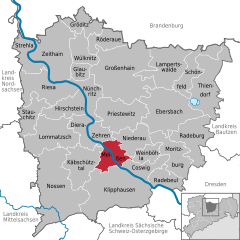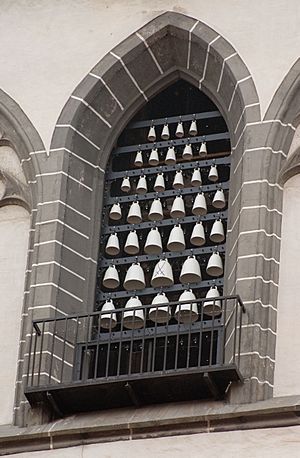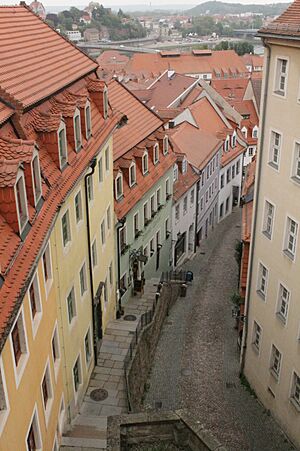Meissen facts for kids
Quick facts for kids
Meissen
Meißen
|
||
|---|---|---|
|
Albrechtsburg
Siebeneichen castle
Market square with church
View over Meißen with its vineyards
|
||
|
||
|
Location of Meissen within Meißen district
 |
||
| Lua error in Module:Location_map at line 530: Unable to find the specified location map definition: "Module:Location map/data/Germany Sachsen" does not exist. | ||
| Country | Germany | |
| State | Saxony | |
| District | Meißen | |
| Subdivisions | 12 Stadtteile/Stadtbezirke | |
| Area | ||
| • Total | 30.90 km2 (11.93 sq mi) | |
| Elevation | 106 m (348 ft) | |
| Population
(2022-12-31)
|
||
| • Total | 29,011 | |
| • Density | 938.87/km2 (2,431.7/sq mi) | |
| Time zone | UTC+01:00 (CET) | |
| • Summer (DST) | UTC+02:00 (CEST) | |
| Postal codes |
01654–01662
|
|
| Dialling codes | 03521 | |
| Vehicle registration | MEI, GRH, RG, RIE | |
| Website | www.stadt-meissen.de | |
Meissen (also spelled Meißen) is a charming town in eastern Germany. It's located in the Free State of Saxony, about 25 kilometers (15 miles) northwest of Dresden. The town sits on both sides of the Elbe river and has about 30,000 people.
Meissen is famous for many things. It's the home of Meissen porcelain, which was the first high-quality porcelain made outside of Asia. You can also find the historic Albrechtsburg castle and the beautiful Gothic Meissen Cathedral here. The Meissen Frauenkirche, a church with a special porcelain bell tower, is another highlight. Meissen is also the capital of the Meissen district.
Contents
History of Meissen
![]() Margraviate of Meissen 968–1002
Margraviate of Meissen 968–1002
![]() Duchy of Poland 1002
Duchy of Poland 1002
![]() Margraviate of Meissen 1002–1423
Margraviate of Meissen 1002–1423
![]() Electorate of Saxony 1423–1806
Electorate of Saxony 1423–1806
![]() Kingdom of Saxony 1806–1871
Kingdom of Saxony 1806–1871
![]() German Empire 1871–1918
German Empire 1871–1918
![]() Weimar Republic 1918–1933
Weimar Republic 1918–1933
![]() Nazi Germany 1933–1945
Nazi Germany 1933–1945
![]() Allied-occupied Germany 1945–1949
Allied-occupied Germany 1945–1949
![]() East Germany 1949–1990
East Germany 1949–1990
![]() Germany 1990–present
Germany 1990–present
Meissen started as a settlement of West Slavic people called Glomatians. In 929, King Henry the Fowler officially founded it as a German town. This marked the beginning of its long history.
Early Development and Important Events
In 968, the Diocese of Meissen was created, making Meissen an important religious center. It became the seat of a bishop. Later, in 1581, the Catholic bishopric ended when the area became Protestant. It was re-established in 1921.
The Margraviate of Meissen, a special border region of the Holy Roman Empire, was founded in 965. Meissen was its capital. By the year 1000, it was a busy market town. The town changed hands a few times, eventually coming under the control of the House of Wettin in 1089.
In 1241, a small group of Mongol warriors attacked Meissen. They defeated the town's defenders, and much of Meissen was destroyed. Luckily, the Mongols left Germany soon after, saving the region from more damage.
Meissen was a key place in the "Ostsiedlung." This was a time when many German settlers moved into the Slavic lands east of the Elbe river. Meissen officially received its town rights in 1332.
Building the Cathedral and Changing Capitals
Construction of the Meissen Cathedral began in 1260. It was built on the same hill as the Albrechtsburg castle. Because of the limited space, it's one of the smallest cathedrals in Europe. It's also known as a beautiful example of Gothic architecture.
In 1423, Meissen became the capital of the Electorate of Saxony. However, the capital was moved to Dresden in 1464.
During World War II, a subcamp of the Flossenbürg concentration camp was located in Meissen. After the war, in 1988, Meissen hosted an important meeting. An agreement was signed there between the German Evangelical Church and the Church of England, showing a step towards religious understanding.
Meissen Porcelain
Meissen is world-famous for making Meissen porcelain. This is because the area has lots of special clays, like china clay (called kaolin) and potter's clay. Meissen porcelain was the first high-quality porcelain made outside of Asia.
The first European porcelain was made in Meissen in 1710. King Augustus II the Strong ordered the Royal-Polish and Electoral-Saxon Porcelain Factory to open in the Albrechtsburg castle. In 1861, the factory moved to the Triebisch river valley in Meissen. You can still find the porcelain factory there today. Besides porcelain, other types of ceramics are also made in the town.
In the old town, you'll find many porcelain stores. They often sell old Meissen porcelain and sometimes even fix broken pieces. Many artists who used to work at the factory now have their own workshops. They create and sell their own porcelain art.
Main Sights to See
Meissen has many interesting places to visit.
Albrechtsburg Castle and Meissen Cathedral
The Albrechtsburg castle was once the home of the House of Wettin family. It's considered the first castle in German-speaking countries to be used as a royal home. Built between 1472 and 1525, it's a great example of late Gothic style. Today, the castle is a museum.
Right next to the castle is the 13th-century Gothic Meissen Cathedral (Meißner Dom). Its chapel is a famous burial place for the Wettin family. From the hill where the castle and cathedral stand, you get amazing views over the old town.
Frauenkirche and Old Town
Meissen's historic center is mostly around the market square, at the bottom of the castle hill. It has many beautiful buildings from the Renaissance period.
You can also get a great view from the 57-meter-high tower of the Frauenkirche (Church of Our Lady). This church was first mentioned in 1205. After a fire around 1450, it was rebuilt in a late Gothic style. Its tower has the world's first porcelain carillon (a set of bells). These bells were made in 1929 to celebrate the town's 1000th birthday.
Festivals and Wine
From spring to autumn, Meissen hosts several fun festivals. These include a pottery market and the Weinfest, which celebrates the wine harvest. Meissen wine is made from grapes grown in the river valley around the town. This area is part of the Saxonian wine region, one of the northernmost wine regions in Europe.
Educational Institutions
Meissen is home to some important schools. The Saxon public elite college, Sächsisches Landesgymnasium Sankt Afra zu Meißen, is located here. Also, the Saxon Civil Servants Academy and the Academy of the Evangelical Church of Saxony are in the town.
Sport
Meissen has a Speedway Stadium on the eastern side of town. This stadium has hosted big international motorcycle racing events. For example, it was a venue for the Speedway World Team Cup in 1965.
Notable People
Many interesting people have connections to Meissen:
- Saint Benno (c. 1010–1106), a former Bishop of Meissen.
- Samuel Hahnemann (1755–1843), a doctor who founded Homoeopathy.
- Louise Otto-Peters (1819–1895), an important activist for women's rights.
- Peter Schreier (1935–2019), a famous opera singer and conductor.
- Ralf Schumann (born 1962), an Olympic gold medalist in shooting.
People Who Worked in Meissen
- Johann Friedrich Böttger (1682–1719), one of the inventors of European porcelain.
- Johann Joachim Kändler (1706–1775), a famous porcelain sculptor.
- Gotthold Ephraim Lessing (1729–1781), a well-known writer who studied at the Sächsisches Landesgymnasium.
Twin Towns – Sister Cities
Meissen has "twin town" relationships with several cities around the world. These partnerships help promote cultural exchange and friendship.
 Vitry-sur-Seine, France (since 1973)
Vitry-sur-Seine, France (since 1973) Arita, Japan (since 1979)
Arita, Japan (since 1979) Fellbach, Germany (since 1987)
Fellbach, Germany (since 1987) Litoměřice, Czech Republic (since 1996)
Litoměřice, Czech Republic (since 1996) Corfu, Greece (since 1996)
Corfu, Greece (since 1996) Provo, United States (since 2001)
Provo, United States (since 2001) Legnica, Poland (since 2017)
Legnica, Poland (since 2017)
See also
 In Spanish: Meißen para niños
In Spanish: Meißen para niños










